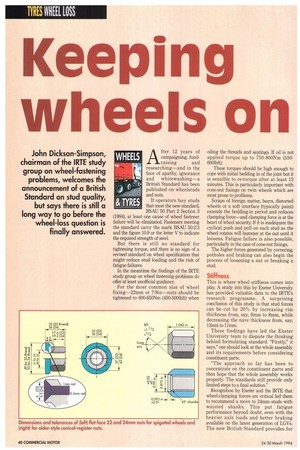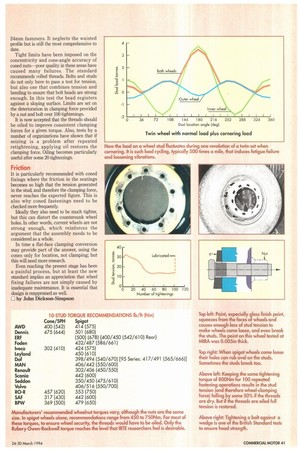Keeping wheels on
Page 44

Page 45

If you've noticed an error in this article please click here to report it so we can fix it.
John Dickson-Simpson, chairman of the IRTE study group on wheel-fastening problems, welcomes the announcement of a British Standard on stud quality, but says there is still a long way to go before the wheel-loss question is finally answered. After 12 years of campaigning, fundraising and researching—and in the face of apathy, ignorance and whitewashing—a British Standard has been published on wheelstuds and nuts.
If operators buy studs that meet the new standard, BSAU 50 Part 2 Section 3 (1994), at least one cause of wheel fastener failure will be eliminated_ Fasteners meeting the standard carry the mark BSAU 50:2:3 and the figure 10.9 or the letter V to indicate the required strength of steel.
But there is still no standard for tightening torque, and there is no sign of a revised standard on wheel specification that might reduce stud loading and the risk of fatigue failures.
In the meantime the findings of the IRTE study group on wheel fastening problems do offer at least unofficial guidance.
For the most common size of wheel fixing-22mm or 7/8in—nuts should be tightened to 600-650Nm (450-5001bf-t) when
WHEELS
)
& TYRES
oiling the threads and seatings. If oil is not applied torque up to 750-800Nm (5506001bft). These torques should be high enough to cope with initial bedding in of the joint but it is sensible to re-torque after at least 15 minutes. This is particularly important with cone-nut fixings on twin wheels which are most prone to problems.
Scraps of foreign matter, burrs, distorted wheels or a soft interface (typically paint) extends the bedding-in period and reduces clamping force—and clamping force is at the heart of wheel security If it is inadequate the cyclical push and pull on each stud as the wheel rotates will hammer at the nut until it loosens. Fatigue failure is also possible, particularly in the case of cone-nut fixings.
The higher forces generated by cornering, potholes and braking can also begin the process of loosening a nut or breaking a stud.
Stiffness
This is where wheel stiffness comes into play. A study into this by Exeter University has provided valuable data to the IRTE's research programme. A surprising conclusion of this study is that stud forces can be cut by 20% by increasing rim thickness from, say, 6mm to 8mm, while decreasing the nave thickness from, say, 13mm to llmm. These findings have led the Exeter University team to dispute the thinking behind formulating standard. "Firstly," it says," one should look at the whole assembly and its requirements before considering constituent parts.
"The approach so far has been to concentrate on the constituent parts and then hope that the whole assembly works properly. The standards still provide only limited steps to a final solution."
Recognition by Exeter and the IRTE that wheel-clamping forces are critical led them to recommend a move to 24mm studs with waisted shanks. This put fatigue performance beyond doubt, even with the heavier axle loads and better braking available on the latest generation of LGVs. The new British Standard provides for 24mm fasteners. It neglects the waisted profile but is still the most comprehensive to date.
Tight limits have been imposed on the concentricity and cone-angle accuracy of coned nuts—poor quality in these areas have caused many failures. The standard recommends rolled threads. Bolts and studs do not only have to pass a test for tension, but also one that combines tension and bending to ensure that bolt heads are strong enough. In this test the head registers against a sloping surface. Limits are set on the deterioration in clamping force provided by a nut and bolt over 100 tightenings.
It is now accepted that the threads should be oiled to improve consistent clamping forces for a given torque. Also, tests by a number of organizations have shown that if seizing is a problem after repeated retightening, applying oil restores the clamping force. Oiling becomes particularly useful after some 20 tightenings.
Friction
It is particularly recommended with coned fixings where the friction in the seatings becomes so high that the tension generated in the stud, and therefore the clamping force, never reaches the expected figure. This is also why coned fastenings need to be checked more frequently.
Ideally they also need to be much tighter, but this can distort the countersunk wheel holes. In other words, current wheels are not strong enough, which reinforces the argument that the assembly needs to be considered as a whole.
In time a flat-face clamping conversion may provide part of the answer, using the cones only for location, not clamping; but this will need more research.
Even reaching the present stage has been a painful process, but at least the new standard implies an appreciation that wheel fixing failures are not simply caused by inadequate maintenance. It is essential that design is reappraised as well.
Li by John Dickson-Simpson
































































































